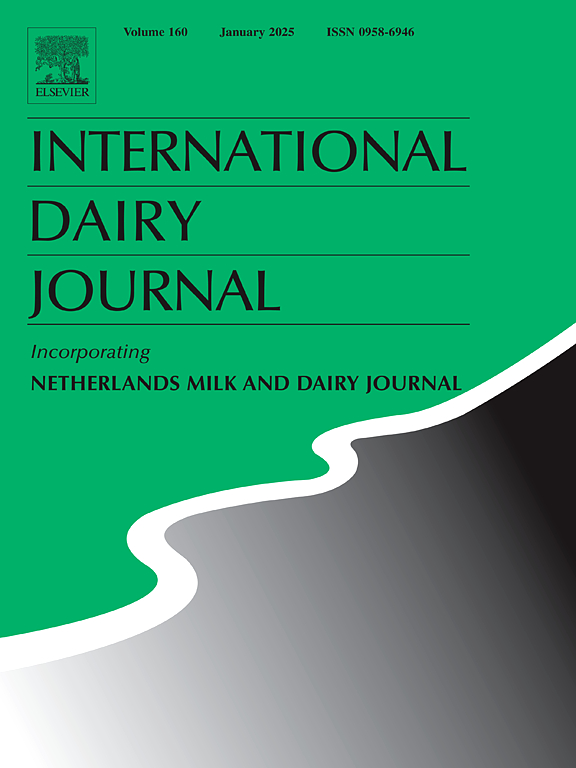Milk protein hydrolysates obtained with immobilized alcalase: Antioxidant properties of hydrolysates and milk fat stability
IF 3.4
3区 农林科学
Q2 FOOD SCIENCE & TECHNOLOGY
引用次数: 0
Abstract
This study investigated the catalytic activity of immobilized alcalase in producing milk protein hydrolysates (MPHs), their antioxidant properties, and the stability of their fat. Alcalase was immobilized on three functionalised resins, with the hydrolysis conditions being enzyme to substrate ratio of 1000 units/g of milk, pH 8.0, temperature 50 °C and hydrolysis time of 10 min. Alcalase immobilized on octadecyl-activated resin was found to be more active with multiple reuse properties, retaining 80 % of its catalytic activity after ten reuses. The antioxidant activities of all the MPH produced were tested and were shown to inhibit the oxidative destruction of β-carotene more effectively than the unhydrolysed milk. MPH production was then scaled up in a custom-built enzyme reactor for controlled yield. Milk fat analyses using gas chromatography with flame ionization detection (GC-FID) and Iatroscan-FID showed that the lipid classes and fatty acid compositions of the unhydrolysed milk and MPH remain unchanged. The peroxide value (POV), p-Anisidine (p-AV) and Thiobarbituric Acid (TBARS) tests showed that lipid oxidation occurred more in the unhydrolysed milk compared to the MPH after 18 weeks of storage. This study concludes that immobilization can significantly improve the properties of alcalase and increase the number of hydrolysis cycles that it can perform while being used to produce high-quality MPH with improved antioxidant properties and stable lipids.
固定化alcalase制得的乳蛋白水解物:水解物的抗氧化性能和乳脂肪的稳定性
研究了固定化碱性磷酸酶对乳蛋白水解产物(MPHs)的催化活性、抗氧化性能及其脂肪的稳定性。将Alcalase固定在三种功能化树脂上,水解条件为酶底物比为1000单位/g牛奶、pH为8.0、温度为50℃、水解时间为10 min。结果表明,在十八烷基活化树脂上固定的Alcalase具有更强的活性,具有多次重复使用的特性,重复使用10次后仍保持80%的催化活性。所有生产的MPH的抗氧化活性被证明比未水解的牛奶更有效地抑制β-胡萝卜素的氧化破坏。然后在一个定制的酶反应器中扩大MPH的生产,以控制产量。采用气相色谱火焰电离检测(GC-FID)和Iatroscan-FID对乳脂进行分析,发现未水解乳和MPH的脂类和脂肪酸组成保持不变。过氧化值(POV)、对茴香胺(p-AV)和硫代巴比妥酸(TBARS)测试表明,与MPH相比,18周后未水解的牛奶中脂质氧化发生更多。本研究得出结论,固定化可以显著改善alcalase的性能,增加其水解循环次数,同时用于生产具有改善抗氧化性能和稳定脂质的高质量MPH。
本文章由计算机程序翻译,如有差异,请以英文原文为准。
求助全文
约1分钟内获得全文
求助全文
来源期刊

International Dairy Journal
工程技术-食品科技
CiteScore
6.50
自引率
9.70%
发文量
200
审稿时长
49 days
期刊介绍:
The International Dairy Journal publishes significant advancements in dairy science and technology in the form of research articles and critical reviews that are of relevance to the broader international dairy community. Within this scope, research on the science and technology of milk and dairy products and the nutritional and health aspects of dairy foods are included; the journal pays particular attention to applied research and its interface with the dairy industry.
The journal''s coverage includes the following, where directly applicable to dairy science and technology:
• Chemistry and physico-chemical properties of milk constituents
• Microbiology, food safety, enzymology, biotechnology
• Processing and engineering
• Emulsion science, food structure, and texture
• Raw material quality and effect on relevant products
• Flavour and off-flavour development
• Technological functionality and applications of dairy ingredients
• Sensory and consumer sciences
• Nutrition and substantiation of human health implications of milk components or dairy products
International Dairy Journal does not publish papers related to milk production, animal health and other aspects of on-farm milk production unless there is a clear relationship to dairy technology, human health or final product quality.
 求助内容:
求助内容: 应助结果提醒方式:
应助结果提醒方式:


